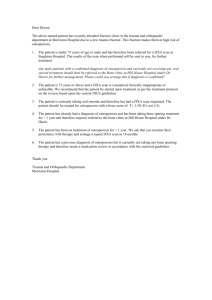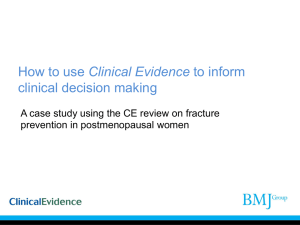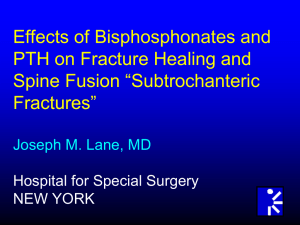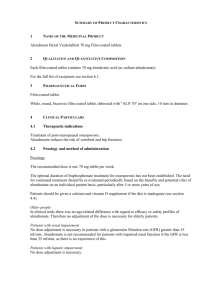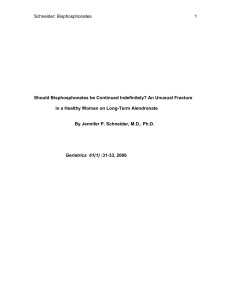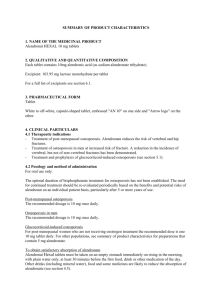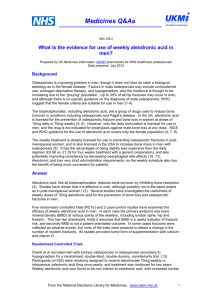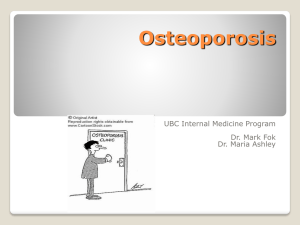Alendronat STADA 10 mg tablet ENG SmPC
advertisement
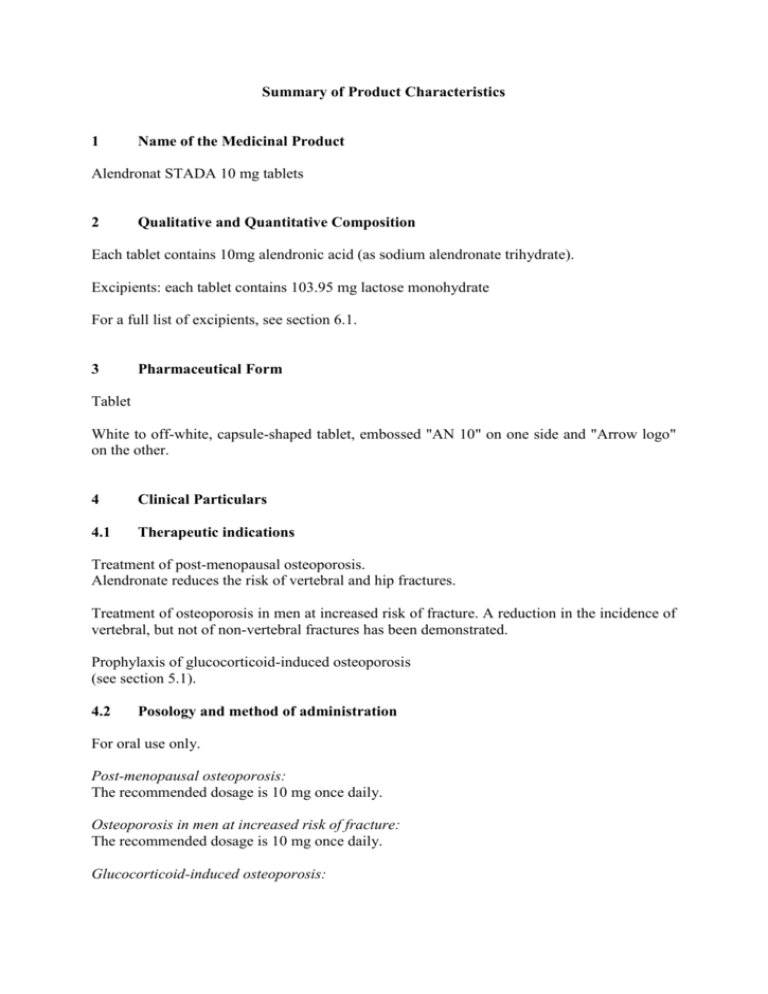
Summary of Product Characteristics
1
Name of the Medicinal Product
Alendronat STADA 10 mg tablets
2
Qualitative and Quantitative Composition
Each tablet contains 10mg alendronic acid (as sodium alendronate trihydrate).
Excipients: each tablet contains 103.95 mg lactose monohydrate
For a full list of excipients, see section 6.1.
3
Pharmaceutical Form
Tablet
White to off-white, capsule-shaped tablet, embossed "AN 10" on one side and "Arrow logo"
on the other.
4
Clinical Particulars
4.1
Therapeutic indications
Treatment of post-menopausal osteoporosis.
Alendronate reduces the risk of vertebral and hip fractures.
Treatment of osteoporosis in men at increased risk of fracture. A reduction in the incidence of
vertebral, but not of non-vertebral fractures has been demonstrated.
Prophylaxis of glucocorticoid-induced osteoporosis
(see section 5.1).
4.2
Posology and method of administration
For oral use only.
Post-menopausal osteoporosis:
The recommended dosage is 10 mg once daily.
Osteoporosis in men at increased risk of fracture:
The recommended dosage is 10 mg once daily.
Glucocorticoid-induced osteoporosis:
For post-menopausal women who are not receiving oestrogen treatment the recommended
dose is one 10 mg tablet daily. For other populations, see summary of product characteristics
for preparations that contain 5 mg alendronate.
Duration of use
The optimal duration of bisphosphonate treatment for osteoporosis has not been established.
The need for continued treatment should be re-evaluated periodically based on the benefits
and potential risks of alendronic acid on an individual patient basis, particularly after 5 or
more years of use.
To obtain satisfactory absorption of alendronate
Alendronat STADA tablets must be taken at least 30 minutes before the first food, beverage
or other medication of the day with plain water only. Other beverages (including mineral
water), food and some medicines are likely to reduce the absorption of alendronate (see
section 4.5).
To assist delivery to the stomach and thus reduce the risk of irritation/side effects locally and
in the oesophagus (see section 4.4)
Alendronat STADA tablets should only be swallowed upon arising for the day with a
whole glass of water (not less than 200 ml or 7 fl. oz).
Alendronat STADA tablets should be swallowed whole. Patients should not crush or
chew the tablet or allow the tablet to dissolve in the mouth because of the risk of
oropharyngeal ulceration.
Patients should not lie down until after the first food of the day, which must be at least 30
minutes after taking the tablet.
Patients should not lie down for at least 30 minutes after taking Alendronat STADA
10 mg tablets.
Alendronat STADA 10 mg tablets should not be taken at bedtime or before arising for the
day.
Patients should be given a calcium and vitamin D supplement if the diet is inadequate (see
section 4.4).
RMS comment: Please move the text above about duration of treatment and place it after the
dosage according to agreed CSP.
Use in elderly patients:
In clinical trials there was no age-related difference with regard to efficacy or safety profiles
of alendronate. Therefore no adjustment of the dose is necessary for elderly patients.
Use in impaired renal function
No dose adjustment is necessary in patients with a glomerular filtration rate (GFR) greater
than 35 ml/min. Alendronate is not recommended for patients with impaired renal function if
the GFR is less than 35 ml/min, as there is no experience of this.
Use in impaired hepatic function
No dose adjustment is necessary.
Paediatric patients
Alendronate sodium is not recommended for use in children under the age of 18 years due to
insufficient data on safety and efficacy in conditions associated with paediatric osteoporosis
(also see section 5.1).
4.3
Contraindications
Oesophageal abnormalities and other factors that delay oesophageal emptying, such as
stricture or achalasia.
Inability to stand or sit upright for at least 30 minutes.
Hypersensitivity to alendronate, other bisphosphonates or to any of the excipients.
Hypocalcaemia.
See also section 4.4.
4.4
Special warnings and precautions for use
Alendronate can cause local irritation to the upper gastrointestinal mucosa. As there is a risk
of worsening of the underlying disease, caution should be observed if alendronate is given to
patients with active upper gastrointestinal tract problems, such as dysphagia, oesophageal
disease, gastritis, duodenitis, ulcers, or with a recent history (during the last year) of major
gastrointestinal disease such as peptic ulcer, active gastrointestinal bleeding or surgery of the
upper gastrointestinal tract other than pyloroplasty (see section 4.3). In patients with known
Barrett's oesophagus, prescribers should consider the benefits and potential risks of
alendronate on an individual patient basis.
Oesophageal reactions (in some cases severe and requiring hospitalisation) such as
oesophagitis, oesophageal ulcers or oesophageal erosions, in rare cases followed by
oesophageal stricture, have been reported in patients receiving alendronate. Physicians should
therefore be alert to any signs or symptoms signalling a possible oesophageal reaction. The
patients should be instructed to discontinue alendronate and seek medical attention if they
develop symptoms of oesophageal irritation such as dysphagia, pain on swallowing,
retrosternal pain or new/worsened heartburn.
The risk of severe oesophageal side effects is thought to be greater in patients who do not take
alendronate correctly and/or continue to take alendronate after developing symptoms
indicative of oesophageal irritation. It is very important that complete administration
instructions are given to, and understood, by the patient (see section 4.2). Patients should be
informed that the risk of oesophageal problems may increase if they do not follow these
instructions.
Despite no increased risk having been observed in extensive clinical trials, there have been
rare (post-marketing) reports of gastric and duodenal ulcers, some of them severe and with
complications. A causal relationship cannot be excluded (see section 4.8).
Osteonecrosis of the jaw, generally associated with tooth extraction and/or local infection
(including osteomyelitis) has been reported in patients with cancer receiving treatment
regimens including primarily intravenously administered bisphosphonates. Many of these
patients were also receiving chemotherapy and corticosteroids. Osteonecrosis of the jaw has
also been reported in patients with osteoporosis receiving oral bisphosphonates.
The following risk factors should be considered when evaluating an individual’s risk of
developing osteonecrosis of the jaw:
• potency of the bisphosphonate (highest for zoledronic acid), route of administration (see
above) and cumulative dose
• cancer, chemotherapy, radiotherapy, corticosteroids, smoking
• a history of dental disease, poor oral hygiene, periodontal disease) invasive dental
procedures and poorly fitting dentures.
A dental examination with appropriate preventive dentistry should be considered prior to
treatment with oral bisphosphonates in patients with poor dental status.
While on treatment, these patients should avoid invasive dental procedures if possible. For
patients who develop osteonecrosis of the jaw while on bisphosphonate therapy, dental
surgery may exacerbate the condition. For patients requiring dental procedures, there are no
data available to suggest whether discontinuation of bisphosphonate treatment reduces the
risk of osteonecrosis of the jaw.
Clinical judgement of the treating physician should guide the management plan of each
patient based on individual benefit/risk assessment.
During bisphosphonate treatment, all patients should be encouraged to maintain good oral
hygiene, receive routine dental check-ups, and report any oral symptoms such as dental
mobility, pain, or swelling.
Bone, joint, and/or muscle pain has been reported in patients taking bisphosphonates. In
postmarketing experience, these symptoms have rarely been severe and/or incapacitating (see
section 4.8).
The time to onset of symptoms varied from one day to several months after starting treatment.
Most patients had relief of symptoms after stopping. A subset had recurrence of symptoms
when rechallenged with the same drug or another bisphosphonate.
Atypical fractures of the femur
Atypical subtrochanteric and diaphyseal femoral fractures have been reported with
bisphosphonate therapy, primarily in patients receiving long-term treatment for osteoporosis.
These transverse or short oblique, fractures can occur anywhere along the femur from just
below the lesser trochanter to just above the supracondylar flare. These fractures occur after
minimal or no trauma and some patients experience thigh or groin pain, often associated with
imaging features of stress fractures, weeks to months before presenting with a completed
femoral fracture. Fractures are often bilateral; therefore the contralateral femur should be
examined in bisphosphonate-treated patients who have sustained a femoral shaft fracture.
Poor healing of these fractures has also been reported. Discontinuation of bisphosphonate
therapy in patients suspected to have an atypical femur fracture should be considered pending
evaluation of the patient, based on an individual benefit risk assessment.
During bisphosphonate treatment patients should be advised to report any thigh, hip or groin
pain and any patient presenting with such symptoms should be evaluated for an incomplete
femur fracture.
In post-marketing experience, there have been rare reports of severe skin reactions including
Stevens-Johnson syndrome and toxic epidermal necrolysis.
Alendronate is not recommended for patients with impaired renal function if the GFR is less
than 35 ml/min (see section 4.2).
Causes of osteoporosis other than oestrogen deficiency and ageing should be considered.
Hypocalcaemia must be corrected before treatment with alendronate is initiated (see section
4.3). Other disorders affecting mineral metabolism (such as vitamin D deficiency and
hypoparathyroidism) should also be effectively treated before starting alendronate. In patients
with these conditions, serum calcium and symptoms of hypocalcaemia should be monitored
during treatment with alendronate.
On account of the positive effects of alendronate on the increase in bone mineralisation,
reductions in serum calcium and serum phosphate may occur especially in patients taking
glucocorticoids in whom calcium absorption may be decreased. These are usually slight and
asymptomatic. However, in rare cases, symptomatic hypocalcaemia has been reported which
occasionally has been severe and often occurred in patients with predisposing conditions (e.g.
hypoparathyroidism, vitamin D deficiency and in cases of calcium malabsorption).
It is therefore particularly important to ensure that patients taking glucocorticoids have an
adequate calcium and vitamin D intake.
Excipients
Alendronat STADA 10 mg tablets contain lactose. Patients with rare hereditary problems of
galactose intolerance, the Lapp lactase deficiency or glucose-galactose malabsorption should
not take this medicine.
4.5
Interactions with other medicinal products and other forms of interaction
If taken at the same time, it is likely that foods and beverages (including mineral water),
calcium supplements, antacids and some oral medicines will affect the absorption of
alendronate. Patients must therefore wait for at least 30 minutes after taking alendronate
before taking any other oral medicine (see section 4.2 and 5.2).
Since NSAID use is associated with gastrointestinal irritation, caution should be used during
concomitant use with alendronate.
No other clinically significant drug interactions are expected. A number of patients in the
clinical trials received oestrogen (intravaginal, transdermal or oral) concomitantly with
alendronate. No undesirable effects could be related to the combination treatment.
No specific interaction studies have been carried out, but alendronate was used in clinical
trials concomitantly with a number of other commonly prescribed medicines without any
evidence of clinically unfavourable interactions.
4.6
Pregnancy and lactation
Use during pregnancy
Alendronate should not be used during pregnancy. There are no adequate data from the use of
alendronate in pregnant women. Animal studies do not indicate direct harmful effects with
respect to pregnancy, embryonal/fetal development, or postnatal development. Alendronate
given during pregnancy in rats caused dystocia related to hypocalcemia (see section 5.3).
Use during lactation
It is not known whether alendronate is excreted into human breast milk. Alendronate should
not be used by breast-feeding women.
4.7
Effects on ability to drive and use machines
No studies on the effects on the ability to drive and use machines have been performed.
However, certain adverse reactions that have been reported with Alendronat STADA 10 mg
tablets may affect some patients' ability to drive or operate machinery. Individual responses to
Alendronat STADA 10 mg tablets may vary (see section 4.8).
4.8
Undesirable effects
In a one-year study in post-menopausal women with osteoporosis the overall safety profiles of
for alendronate once-weekly 70 mg (n=519) and alendronate 10 mg/day (n=370) were similar.
In two three-year studies of almost identical design, with post-menopausal women
(alendronate 10 mg: n=196; placebo: n= 397) the overall safety profiles for alendronate
10 mg/day and placebo were similar.
Undesirable effects reported by the investigators as possibly, probably or definitely related to
the drug are presented below if they occurred in 1 % of any in the treatment groups in the
one-year study or in 1 % of the patients who were treated with alendronate 10 mg/day and
with an incidence higher than in patients who were treated with placebo in three-year studies.
Gastrointestinal
Abdominal pain
Dyspepsia
Acid regurgitation
Nausea
Abdominal distension
Constipation
Diarrhoea
Dysphagia
Flatulence
Gastritis
Gastric ulcer
Oesophageal ulcer
Musculoskeletal
Musculoskeletal pain
One-year study
Alendronate
once-weekly
70 mg
(n=519)
%
Alendronate
10 mg/day
(n=370)
%
Three-year studies
Alendronate
Placebo
10 mg/day
(n=397)
(n=196)
%
%
3.7
2.7
1.9
1.9
1.0
0.8
0.6
0.4
0.4
0.2
0.0
0.0
3.0
2.2
2.4
2.4
1.4
1.6
0.5
0.5
1.6
1.1
1.1
0.0
6.6
3.6
2.0
3.6
1.0
3.1
3.1
1.0
2.6
0.5
0.0
1.5
4.8
3.5
4.3
4.0
0.8
1.8
1.8
0.0
0.5
1.3
0.0
0.0
2.9
3.2
4.1
2.5
(bone, muscle or joints)
Muscle cramps
Neurological
Headache
One-year study
Alendronate
once-weekly
70 mg
(n=519)
%
Alendronate
10 mg/day
(n=370)
%
Three-year studies
Alendronate
Placebo
10 mg/day
(n=397)
(n=196)
%
%
0.2
1.1
0.0
1.0
0.4
0.3
2.6
1.5
The following undesirable effects have also been reported in clinical trials and/or post
marketing:
In this section frequencies of undesirable effects are defined as follows: Very common (≥
1/10); common (≥ 1/100 to < 1/10); uncommon (≥ 1/1,000 to < 1/100); rare (≥ 1/10,000 to <
1/1,000); very rare (< 1/10,000), not known (cannot be estimated from the available data).
Immune system disorders:
Rare: Hypersensitivity reactions including urticaria and angioedema.
Metabolism and nutrition disorders:
Rare: Symptomatic hypocalcaemia, often in association with predisposing conditions§.
Nervous system disorders:
Common: Headache, dizziness†.
Uncommon: Dysgeusia†.
Eye disorders:
Uncommon: Eye inflammation (uveitis, scleritis, episcleritis).
Ear and labyrinth disorders:
Common: Vertigo†.
Gastrointestinal disorders:
Common: Abdominal pain, dyspepsia, constipation, diarrhoea, flatulence, oesophageal ulcer*,
dysphagia*, abdominal distension, acid regurgitation.
Uncommon: Nausea, vomiting, gastritis, oesophagitis*, oesophageal erosions*, melaena†.
Rare: Oesophageal stricture*, oropharyngeal ulceration*, upper gastrointestinal PUBs
(perforation, ulcers, bleeding)§.
Skin and subcutaneous tissue disorders:
Common: Alopecia†, pruritus†.
Uncommon: Rash, erythema.
Rare: Skin rash with photosensitivity, severe skin reactions including Stevens-Johnson
syndrome and toxic epidermal necrolysis‡.
Musculoskeletal and connective tissue disorders:
Very common: Musculoskeletal (bone, muscle or joint) pain which is sometimes severe†§.
Common: Joint swelling†.
Rare: Osteonecrosis of the jaw ‡§, atypical subtrochanteric and diaphyseal femoral fractures
(bisphosphonate class adverse reaction)⊥.
General disorders and administration site conditions:
Common: Asthenia†, peripheral oedema†.
Uncommon: Transient symptoms as in an acute phase response (myalgia, malaise and rarely,
fever) typically in association with initiation of treatment†.
§
See section 4.4
Frequency in Clinical Trials was similar in the drug and placebo group.
* See sections 4.2 and 4.4
‡
This adverse reaction was identified through post-marketing surveillance. The frequency of rare was
estimated based on relevant clinical trials.
⊥ Identified in postmarketing experience
†
Reporting of suspected adverse reactions
Reporting suspected adverse reactions after authorisation of the medicinal product is
important. It allows continued monitoring of the benefit/risk balance of the medicinal product.
Healthcare professionals are asked to report any suspected adverse reactions via {to be
completed nationally: the national reporting system listed in Appendix V}.
4.9
Overdose
Hypocalcaemia, hypophosphataemia and upper gastrointestinal side effects such as upset
stomach, heartburn, oesophagitis, gastritis or ulcer can occur on oral overdosage.
No specific information is available on the treatment of overdosage with alendronate. Milk or
antacids should be given in order to bind alendronate. On account of the risk of oesophageal
irritation, vomiting should not be induced and the patient should be kept in an upright
position.
5
Pharmacological Properties
5.1
Pharmacodynamic properties
Pharmacotherapeutic group: Drugs for treatment of bone diseases, bisphosphonates.
ATC code: M05BA04
The active substance in Alendronat STADA 10 mg tablets, sodium alendronate trihydrate, is a
bisphosphonate that inhibits osteoclastic bone resorption without any direct effect on bone
formation. Preclinical studies have demonstrated a preference for localisation of alendronate
to sites where active resorption takes place. Osteoclastic activity is inhibited, but formation
and binding of the osteoclasts is not affected. Bone formed during treatment with alendronate
is of normal quality.
Treatment of post-menopausal osteoporosis
Osteoporosis is defined as bone mineral density (BMD) of the spine or hip 2.5 standard
deviations below the mean value of a normal young population or as a previous fragility
fracture, irrespective of bone mineral density.
The effects of alendronate on BMD and fracture incidence in post-menopausal women were
studied in two initial efficacy studies of identical design (n=994), and in the Fracture
Intervention Trial (FIT: n=6459).
In the initial efficacy studies, the increases in BMD with alendronate 10 mg daily relative to
placebo after three years were 8.8 %, 5.9 % and 7.8 % at the spine, femoral neck and
trochanter respectively. Total BMD also increased significantly. In the patients treated with
alendronate, the proportion of patients who suffered one or more vertebral fractures was
reduced by 48 % (alendronate 3.2 % versus placebo 6.2 %). In the two-year extensions of
these studies the BMD in the spine and trochanter continued to increase. In addition, BMD at
the femoral neck and total body was maintained.
The FIT study included two placebo-controlled trials in which alendronate was given daily
(5 mg daily for two years and 10 mg daily for a further one or two years).
FIT 1: A three-year study with 2027 patients who had had at least one baseline vertebral
(compression) fracture. In this study alendronate daily reduced the incidence of 1 new
vertebral fracture by 47 % (alendronate 7.9 % versus placebo 15.0 %). In addition, a
statistically significant reduction in the incidence of hip fractures was confirmed (1.1 %
versus 2.2 %, a reduction of 51 %).
FIT 2: A four-year study with 4432 patients who had a low bone mass but had not had
any vertebral fracture at the start of the study. In this study, in a subgroup analysis of
osteoporotic women (37 % of the total population who fulfilled the definition of
osteoporosis given above) a significant difference was seen in the incidence of hip
fractures (alendronate 1.0 % versus placebo 2.2 %, a reduction of 56 %) and in the
incidence of 1 vertebral fracture (2.9 % versus 5.8 %, a reduction of 50 %).
Osteoporosis in men with increased risk of fracture
The efficacy of alendronate 10 mg once daily in men (31-87 years, mean age 63 years, n=241)
with osteoporosis was evaluated in a two-year study. After two years of treatment with
alendronate 10 mg/day, BMD increased on average by 5.3 % in the spine, by 2.6 % in the
femoral neck, by 3.1 % in the trochanter, and by 1.6 % for the skeleton as a whole, relative to
placebo (p<0.001 for all measurement points). The effect of alendronate on BMD was
independent of age, race, gonadal function, baseline BMD or baseline bone turnover. The
incidence of new vertebral fractures was evaluated as a safety variable. In a retrospective
analysis (assessed by quantitative radiography) one new fracture (0.8 %) was documented
among patients treated with alendronate, compared with 6 new fractures (7.1 %) for placebo
(p=0.017). The reduction in height was less after treatment with alendronate, relative to
placebo (-0.6 mm and 2.4 mm respectively, p=0.02). No effect on non-vertebral fractures was
seen.
Glucocorticoid-induced osteoporosis
Long-term use of steroids is often associated with the development of osteoporosis
accompanied by fractures. This occurs in both men and women of all ages. The efficacy of
alendronate 10 mg and alendronate 5 mg once daily in men and women treated with steroids
(at least 7.5 mg/day of prednisone or equivalent, median dose 10 mg/day) was demonstrated
in two one-year studies of practically identical design. These studies involved a total of 560
patients aged 17-83 years. The patients received calcium and vitamin D supplements. Relative
to placebo, BMD increased significantly in the spine (2.41 %), femoral neck (2.19 %) and
trochanter (1.65 %) in patients who were treated with alendronate 5 mg once daily. The
increases in BMD with alendronate 10 mg once daily were the same as for alendronate 5 mg
once daily in all patients, with the exception of post-menopausal women who were not being
treated with oestrogen. In these women the increases (relative to placebo) with alendronate
10 mg once daily were greater than for alendronate 5 mg once daily in the spine (4.11 %
versus 1.56 %) and trochanter (2.84 % versus 1.67 %). The fracture-preventing effect of
increasing bone density with alendronate 10 mg or alendronate 5 mg in corticosteroid-induced
osteoporosis has not been established.
Alendronate 10 mg and 5 mg were effective irrespective of the dose or duration of steroid use.
In addition, alendronate 10 mg and alendronate 5 mg were effective irrespective of age (< 65
years as against 65 years), gender, baseline BMD, baseline bone turnover and concomitant
use of a number of common medicines. In the patients who received alendronate in doses up
to 10 mg daily and in whom biopsy was performed after one year no signs of a disturbance of
the bone mineralisation process were seen.
Paediatric patients
Alendronate sodium has been studied in a small number of patients with osteogenesis
imperfecta under the age of 18 years. Results are insufficient to support the use of alendronate
sodium in paediatric patients with osteogenesis imperfecta.
5.2
Pharmacokinetic properties
Absorption
Compared with an intravenous reference dose, the mean oral bioavailability of alendronate in
women was 0.64 % for doses ranging from 5 to 70 mg given after an overnight fast and two
hours before a standardised breakfast. Bioavailability decreased to an estimated 0.46 % and
0.39 % when alendronate was given an hour or half an hour before a standardised breakfast.
In osteoporosis studies alendronate was effective when it was given at least 30 minutes before
the first meal or drink of the day. Bioavailability was negligible irrespective of whether
alendronate was given together with or up to two hours after a standardised breakfast.
Concomitant administration of alendronate with coffee or orange juice reduced bioavailability
by approx. 60 %. In healthy persons, oral prednisolone (20 mg three times daily for five days)
did not result in any clinically meaningful change in the oral bioavailability of alendronate (a
mean increase ranging from 20 % to 44 %).
Distribution
Studies in rats show that alendronate is initially distributed to soft tissues after intravenous
administration of 1 mg/kg, but is then rapidly redistributed to the skeleton or excreted in the
urine. The mean steady-state volume of distribution, exclusive of bone, is at least 28 litres in
humans. Concentrations of drug in plasma following therapeutic oral doses are too low for
analytical detection (<5 ng/ml). Protein binding in human plasma is approximately 78 %.
Biotransformation
There is no evidence that alendronate is metabolised in animals or humans.
Elimination
Following a single intravenous dose of (14C) alendronate, approximately 50 % of the
radioactivity was excreted in the urine within 72 hours and little or no radioactivity was
recovered in the faeces. Following a single intravenous dose of 10 mg, the renal clearance of
alendronate was 71 ml/min, and systemic clearance did not exceed 200 ml/min. Plasma
concentrations fell by more than 95 % within 6 hours following intravenous administration.
The terminal half-life in humans is estimated to exceed ten years, reflecting release of
alendronate from the skeleton. Alendronate is not excreted through the acidic or basic
transport systems of the kidney in rats, and thus it is not thought to interfere with the excretion
of other drugs by those systems in humans.
Characteristics in patients
Preclinical studies show that the drug that is not deposited in bone is rapidly excreted in the
urine. No evidence of saturation of bone uptake was found after chronic dosing with
cumulative intravenous doses up to 35 mg/kg in animals. Although no clinical information is
available, it is likely that, as in animals, elimination of alendronate via the kidney will be
reduced in patients with impaired renal function. Therefore, somewhat greater accumulation
of alendronate in bone might be expected in patients with impaired renal function (see section
4.2).
5.3
Preclinical safety data
Conventional studies of general toxicity, genotoxicity and carcinogenicity did not reveal any
special risks for humans. Studies in female rats showed that treatment with alendronate during
pregnancy was associated with dystocia during parturition, which was related to
hypocalcaemia. Studies in which rats were given high doses showed an increased incidence of
incomplete foetal bone formation. The relevance for humans is unknown.
6
Pharmaceutical Particulars
6.1
List of excipients
Microcrystalline cellulose
Lactose monohydrate
Croscarmellose sodium
Magnesium stearate
6.2
Incompatibilities
Not applicable.
6.3
Shelf-life
4 years
6.4
Special precautions for storage
Do not store above 25°C. Store in the original package in order to protect from moisture.
6.5
Nature and contents of container
The tablets are supplied in triplex blister (PVC/PE/PVDC/AL) packaging.
14, 28, 30, 56, 98, 112 and 50 x 1 (unit dose).
Not all pack sizes may be marketed.
6.6
Instructions for use and handling, and for destruction
No special requirements.
7
Marketing Authorisation Holder
To be completed nationally
8
Marketing Authorisation Number
To be completed nationally
9
Date of First Authorisation / Renewal of Authorisation
To be completed nationally
Date of first authorisation: 2004-12-03
Date of last renewal: 2010-02-23
10
Date of Revision of the Text
2014-09-24
